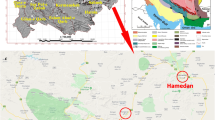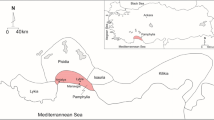Abstract
Mining and quarrying for minor minerals impart significant economic, environmental and social impacts in and around the affected areas. The problem is severe in the small river catchments as the effective area available for assimilating negative impacts of the activity is minimal, compared to large river basins. To address these issues, an investigation has been carried out in two river basins of southern Western Ghats (India)—the Netravati–Gurpur and Periyar–Chalakudy river basins. Both these basins host two important port cities of south India—Kochi and Mangalore. The study reveals that about 6.75 × 106 ty−1 of hard rocks are being extracted in the Netravati–Gurpur basin through 64 quarries. At the same time, the total number of quarries and extracted amounts in the Periyar–Chalakudy river basin are 525 and 10.47 × 106 ty−1, respectively. Many hillocks in the region are turned to a cluster of ugly scars, degrading the ecology and aesthetics of the area. Lowering of water table, modification or disappearance of natural drainages and environmental pollution are some of the other observations noticed in the area. The environmental impacts of laterite quarrying are comparatively less than that of rock quarrying as removal of the hard laterite cap rock enhances water percolation and makes the area more irrigable for agriculture. The study stresses the need for environment-friendly quarrying alternatives with stringent guidelines to improve the overall environmental quality of the area on one hand and to meet the developmental requirements on the other.


Source: Census, 2011)

Source: Department of mines and Geology)










Source: Census reports)


Similar content being viewed by others
References
Abdallah C, Chorowicz J, BouKheir R, Khawlie M (2005) Detecting major terrain parameters relating to mass movements occurrence using GIS, remote sensing and statistical correlations, case study Lebanon. Remote Sens Environ 99:448–461. https://doi.org/10.1016/j.rse.2005.09.014
Avinash K, Jayappa KS, Deepika B (2010) Application of remote sensing and geographic information system in change detection of the Netravati and Gurpur river channels, Karnataka, India. Geocarto Int 25:397–425
Bhagyanagar R, Babita M, Kawal GS, Dwarakish S (2012) Land use/land cover change and urban expansion during 1983–2008 in the coastal area of Dakshina Kannada district, South India. J Appl Remote Sens. https://doi.org/10.1117/1.JRS.6.063576
CGWB (2017) Ground water year book of Karnataka. Ministry of Water Resources, River Development and Ganga Rejuvenation, Government of India, India
Chattopadhyay S, Mahamaya C (1995) Terrain analysis of Kerala, concept, method and application. T.M. No. 1/95.STEC, Thiruvananthapuram
CWRDM (1995) Water atlas of Kerala. Center for Water Resource Development and Management, Kerala
Darwish T, Khater C, Jomaa I, Stehouwer R, Shaban A, Hamze M (2011) Environmental impact of quarries on natural resources in Lebanon. Land Degrad Dev 25:345–358. https://doi.org/10.1002/ldr.1011
DGMS (1975) Circular No. 18 (Tech), Directorate General of Mines Safety, Government of India, India
Ellis EC (2011) Anthropogenic transformation of the terrestrial biosphere. Philos T R Soc A 369:1010–1035. https://doi.org/10.1098/rsta.2010.0331
GSI (1981) Geological and mineral map of Karnataka and Goa. Geol Survey of India, Calcutta
GSI (1995) Geological and mineralogical map of Kerala. Geol Survey of India, Calcutta
Gunn J (1993) The geomorphological impacts of limestone quarrying. Catena Suppl 25:187–197
Gunn J, Bailey D (1993) Limestone quarrying and quarry reclamation in Britain. Environ Geol 21:167–172
Haigh MJ (1978) Evolution of slopes on artificial landforms. University of Chicago, Dept. of Geography Chicago, Research Paper 183, 293 pp
Halada K, Shimada M, Iijima K (2008) Forecasting of the consumption of metals up to 2050. J Jpn Inst Met Mater 71:831–839. https://doi.org/10.2320/jinstmet.71.831
Hancock GR, Lowry JBC, Moliere DR, Evans KG (2008) An evaluation of an enhanced soil erosion and landscape evolution model: a case study assessment of the former Nabarlek uranium mine, Northern Territory, Australia. Earth Surf Proc Land 33:2045–2063. https://doi.org/10.1002/esp.1653
Herrera G, Tomás R, Vicente F, Lopez-Sanchez JM, Mallorquí JJ, Mulas J (2010) Mapping ground movements in open pit mining areas using differential SAR interferometry. Int J Rock Mech Min 47:1114–1125. https://doi.org/10.1016/j.ijrmms.2010.07.006
Khawlie M, Shaban A, Awad M, Faour G, Haddad T (1999) Contribution of remote sensing and GIS in locating quarries for aggregates in Lebanon’s coastal area. In: CNRS, 15th middle East ESRI User Conference, Beirut
Kobayashi H, Watando H, Kakimoto M (2014) A global extent site-level analysis of land cover and protected area overlap with mining activities as an indicator of biodiversity pressure. J Clean Prod 84(1):459–468. https://doi.org/10.1016/j.jclepro.2014.04.049
Langer WH, Drew LJ, Sachs JS (2004) Aggregate and the environment. American Geological Institute Environmental Awareness Series 8 Alexandria VA American Geological Institute, Silver Spring, MD
Macklin MG, Lewin J (1989) Sediment transfer & transformation of an alluvial valley floor: the River South Tyne Northumbria, UK. Earth Surf Proc Land 14:233–246. https://doi.org/10.1002/esp.3290140305
Malmqvist B, Rundle S (2002) Threats to the running water ecosystems of the world. Environ Conserv 29:134–153
Martín-Duque JF, Sanz MA, Bodoque JM, Lucía A, Martín-Moreno C (2010) Restoring earth surface processes through landform design. A 13-year monitoring of a geomorphic reclamation model for quarries on slopes. Earth Surf Proc Land 35:531–548. https://doi.org/10.1002/esp.1950
Maya K, Padmalal D, Babu B, Sheikha EJ (2015) Study on the environmental effects of mining and quarrying in the Periyar river basin, Central Kerala. National Centre for Earth Science Studies, Trivandrum (Unpublished Report)
MMSD (2002) Breaking new ground. Mining, minerals and sustainable development. Earthscan, London
Mossa J, James LA (2013) Impacts of mining on geomorphic systems. In: James LA, Harden C, Clague J (eds) Geomorphology of human disturbances, climate change, and natural hazards, treatise on geomorphology. Academic Press, San Diego, pp 74–95. https://doi.org/10.1016/B978-0-12-374739-6.00344-4
Munasinghe M (1992) Environmental economics and sustainable development. In: UN earth summit, Rio de Janeiro, reproduced as environment paper no. 3, World Bank, Wash. DC
Naik PD, Ushamalini SRK (2007) Noise pollution in stone quarrying industry—a case study in Bangalore District, Karnataka. J Ind Pollut Control 23:43–49
Nair MM (1990) Structural trend line patterns and lineaments of the Western Ghats, south of 13° latitude. J Geol Soc India 35:99–105
Padmalal D, Maya K (2014) Sand mining: environmental impacts and selected case studies. Springer, London
Padmalal D, Maya K, Sreebha S, Sreeja R (2008) Environmental effects of river sand mining: a case from the river catchments of Vembanad lake, Southwest India. Environ Geol 54:879–889
Radhakrishna BP, Vaidyanadhan R (1994) Geology of Karnataka. Geological Society of India, Bangalore
Rogic DG, Matos GR (2008) The global flows of metals and minerals. U.S. Geological Survey, Reston
Sajeev TV, Alex CJ (2017) Mapping of granite quarries in Kerala, India: a critical mapping initiative. Erudite lecture series of Prof. Madhav Gaadgil at School of Legal Studies, Cochin University of Science and Technology, Kochi, India
Sajinkumar KS, Sankar G, Rani VR, Sundarajan P (2014) Effect of quarrying on the slope stability in Banasuramala: an offshoot valley of Western Ghats, Kerala, India. Environ Earth Sci 72:2333–2344. https://doi.org/10.1007/s12665-014-3143-7
Shaban A, El-Baz F, Khawlie M (2007) The relationship between water-wells productivity and lineaments morphometry: selected zones from Lebanon. Nord Hydrol 38:178–201
Sheldon GC, Strongman EJ, Weber-Fahr M (2002) Its not over when it’s over: mine closure around the world. World Bank Group’s Mining Department, World Bank, Washington, D.C
Shiekha EJ (2017) Mining and quarrying in the river catchments of central Kerala around Kochi city, SW India—consequences and sustainable development strategies. Ph.D. Thesis (Unpublished), University of Kerala
Tarolli P, Sofia G (2016) Human topographic signatures and derived geomorphic processes across landscapes. Geomorphology 255:140–161
UNEP, Swilling M, Robinson B, Marvin S, Hodson M (2013) City-level decoupling: urban resource lows and the governance of infrastructure transitions. A report of the working group on cities of the international resource panel
Vedeil E, Faour G, Velut S (2007) Atlasdu Liban territories et socie´te´s. Coll. E´tudes contemporaines. Ed. Institut Francais du Proche-Orient/CNRS Liban, Beyrouth
Vidal O, Goffe B, Arndt N (2013) Metals for a low-carbon society. Nat Geosci 6:894–896
Wellmer FW, Becker-Platen J (2002) Sustainable development and the exploitation of mineral and energy resources: a review. Int J Earth Sci 91:723–745
Acknowledgements
We thank the Director, National Centre for Earth Science Studies (NCESS), Thiruvananthapuram for encouragement and support. Thanks are also due to Shri. Eldhose K. for supporting in field work in Netravati–Gurupur river basins.
Author information
Authors and Affiliations
Corresponding author
Additional information
Publisher's Note
Springer Nature remains neutral with regard to jurisdictional claims in published maps and institutional affiliations.
Rights and permissions
About this article
Cite this article
Vandana, M., John, S.E., Maya, K. et al. Environmental impact of quarrying of building stones and laterite blocks: a comparative study of two river basins in Southern Western Ghats, India. Environ Earth Sci 79, 366 (2020). https://doi.org/10.1007/s12665-020-09104-1
Received:
Accepted:
Published:
DOI: https://doi.org/10.1007/s12665-020-09104-1




